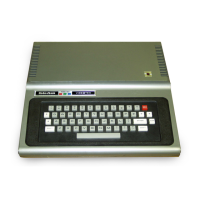APPENDIX
H/Glossary
address A location in memory, usually specified as a two-byte hexadecimal
number. The address range
[0
to FFFF] is represented in decimal as
[0
to 32767]
[ - 32768,
...
, - 1].
alphabetic Referring strictly to the letters A to z.
alphanumeric
Referring to the set
of
letters A to Z and the numerals 0-9.
argument The string
or
numeric quantity which is supplied to a function and is
then operated
on
to derive a result; this result is referred to as the value
of
the
function.
array
An
organized set
of
elements which can be referenced in total
or
individually, using the array name and one or more subscripts. In BASIC, any
variable name can be used to name an
array; and arrays can have one
or
more
dimensions.
AR()
signifies a one-dimensional array named AR;
AR(,)
signifies a
two-dimensional array named
AR; etc.
ASCII
American Standard Code for Information Interchange. This method
of
coding is used to store textual data. Numeric data is typically stored in a more
compressedformat.
BASIC Beginners' All-purpose Symbolic Instruction Code.
binary Having two possible states,
e.g.,
the binary digits 0 and
1.
The binary (base
2)
numbering system uses sequences
of
zeroes and ones to represent quantities.
This is analagous to the
Computer's
internal representation
of
data, using electrical
values for
0 and
1.
bit Binary digit; the smallest unit
of
memory in the Computer, capable
of
representing the values 0 and
1.
break
To
interruptexecution
of
a program. In BASIC the statement STOP causes a
break in execution, as does pressing the
(BREAK)
key.
buffer An area in RAM where datais accumulated for further processing.
byte The smallest addressable unit
of
memory in the Computer, consisting
of
8
consecutive bits, andcapable
of
representing 256 different values,
e.g.,
decimal
values from
0 to 255.
compressed-format A method
of
storing information in less space than a standard
.ASCII representation would require. An integer always requires two bytes; a
single-precisionnumber,
four; a double-precision number, 8 - regardless
of
how
many characters are required to represent the numbers as text. String values are not
storedin compressedformat; eachcharacterrequires one byte.
BASIC programs
in
RAM are storedin compressed-format, with all BASIC keywords
storedas special one-byte codes.
H/1
